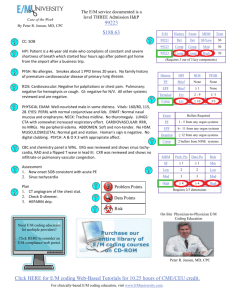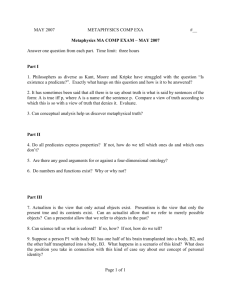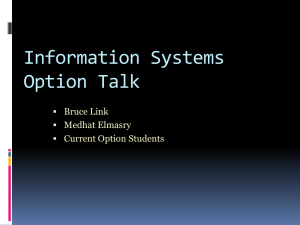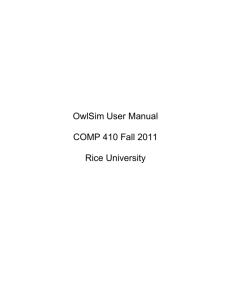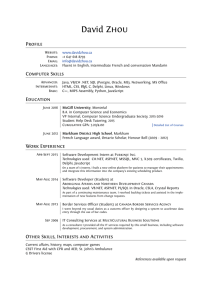COMP 303 Computer Architecture
advertisement
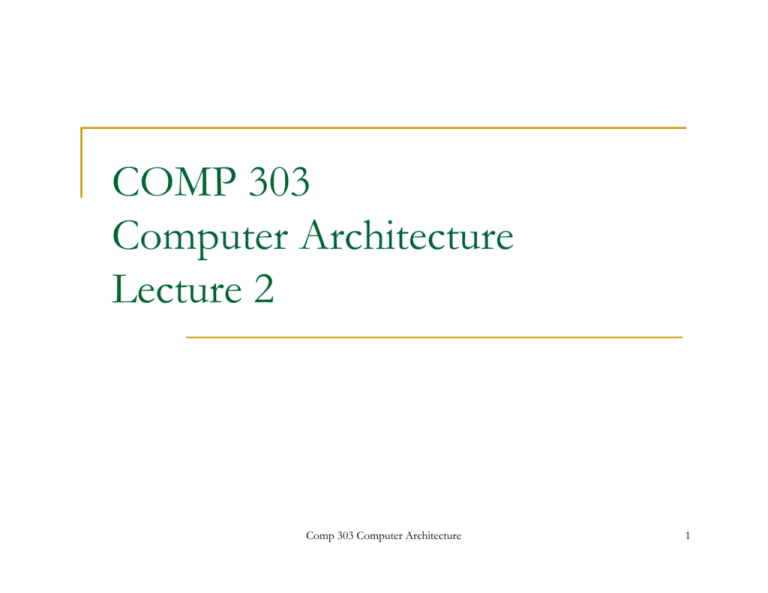
COMP 303
Computer Architecture
Lecture 2
Comp 303 Computer Architecture
1
Hardware Operations
Every computer must be able to perform arithmetic
add a, b, c
In order to do a = b+c+d+e
add a, b, c
# Sum of b+c to a
add a, a, d
# Sum of b+c+d to a
add a, a, e
# Sum of b+c+d+e to a
Comp 303 Computer Architecture
2
Hardware operations
# is used for comments (until the end of line)
The natural number of operands for an operation like
addition is three.
Design Principle 1: Simplicity favors regularity
Comp 303 Computer Architecture
3
Compiling a complex C assignment into
MIPS
f=(g+h)-(i+j)
add t0, g, h # temporary variable t0 contains g+h
add t1, i, j # temporary variable t1 contains i+j
sub f, t0, t1# f gets t0-t1
Comp 303 Computer Architecture
4
MIPS Assembly Language
Arithmetic operations
add. Usage: add a,b,c Meaning: a=b+c
sub. Usage: sub a,b,c Meaning: a=b-c
Comp 303 Computer Architecture
5
Operands of the hardware
Operands of the instructions are from a limited number
of special locations called registers
The size of registers in MIPS is 32 bit.
The word size in MIPS is 32 bit.
MIPS has 32 registers. The reason of 32 registers in
MIPS is
Design Principle 2: Smaller is faster
Comp 303 Computer Architecture
6
Compiling a C assignment using registers
f=(g+h)-(i+j)
The variables f, g, h, i and j are assigned to the registers
$s0, $s1, $s2, $s3 and $s4, respectively
add $t0, $s1, $s2 # temporary variable t0 contains g+h
add $t1, $s3, $s4 # temporary variable t1 contains i+j
sub $s0, $t0, $t1 # f gets t0-t1
Comp 303 Computer Architecture
7
Memory operands
MIPS must include instructions that transfer data
between memory and registers:
Data transfer instructions
Comp 303 Computer Architecture
8
Compiling an assignment when an operand
is in memory
g = h + A[8]
We can add two numbers when they are in registers. So
Offset
transfer the memory data (A[8])into a register.
Assume the base address of the array is stored in $s3
lw $t0,8($s3) # temp reg $t0 gets A[8]
A[8] is in $t0
Base register
add $s1, $s2, $t0 # g = h + A[8]
Comp 303 Computer Architecture
9
Memory organization
Viewed as a large, single-dimension array, with an
address.
A memory address is an index into the array
"Byte addressing" means that the index points to a byte
of memory.
Comp 303 Computer Architecture
10
Memory organization
Bytes are nice, but most data items use larger "words"
For MIPS, a word is 32 bits or 4 bytes.
232 bytes with byte addresses from 0 to 232-1
230 words with byte addresses 0, 4, 8, ... 232-4
Comp 303 Computer Architecture
11
Hardware/Software Interface
In MIPS, words must start at addresses that are multiple
of 4
Alignment restriction
Computers divide into those that use the address of the
leftmost (or “big end”) byte as the word address versus
that use the rightmost (or “little end”) byte.
MIPS is big-endian. In order to get A[8] we should load
32nd byte (which is the 8.th word)
Comp 303 Computer Architecture
12
Alignment
Comp 303 Computer Architecture
13
Load and Store
Assume h is in $s2. The base address of the array A is
in $s3.
A[12] = h + A[8]
lw $t0,32($s3)
# Temporary reg $t0 gets A[8]
add $t0, $s2, $t0 # Temporary reg $t0 gets h+A[8]
sw $t0, 48($s3)
# Stores h+A[8] back into A[12]
Comp 303 Computer Architecture
14
Constant or immediate operands
Adding constants to registers.
Two way:
Load the constant from the memory location
Add immediate
addi $s3, $s3, 4 # $s3 = $s3 + 4
Constant operands occur frequently
Design Principle 3: Make the common case fast
There is no subtract immediate! Why?
Comp 303 Computer Architecture
15
Representing insturctions in the computer
Since all kind of information is stored in computer as
binary digits (bits) there should be binary representations
of instructions.
Mapping of register names into numbers.
In MIPS assembly language
registers $s0 to $s7 map onto register numbers 16 to 23
registers $t0 to $t7 map onto register numbers 8 to 15
Comp 303 Computer Architecture
16
Translating a MIPS Assembly instruction
into a machine instruction
add $t0, $s1, $s2
registers have numbers, $t0=8, $s1=17, $s2=18
Instruction Format:
op: operation code (opcode)
rs: the first register source operand
rt: the second register source operand
rd: the register destination operand
shamt: shift amount. Used in shift operations
funct: function. Specific variant of the opcode (function code)
Comp 303 Computer Architecture
17
Instruction formats
R-type (for register) or R-format
I-type (for immediate) or I-format
Example: lw $t0, 32($s2)
The formats are distinguished by the values in the first
field
Comp 303 Computer Architecture
18
Logical operations
Instruction
Example
Meaning
And
and $s1,$s2,$s3
$s1 = $s2 & $s3
Or
or $s1,$s2,$s3
$s1 = $s2 | $s3
Nor
nor $s1,$s2,$s3
$s1 = ~($s2 | $s3)
And immediate
andi $s1,$s2,100
$s1 = $s2 & 100
Or immediate
ori $s1,$s2,100
$s1 = $s2 | 100
Shift left logical
sll $s1,$s2,10
$s1 = $s2<<10
Shift right logical
srl $s1,$s2,10
$s1 = $s2>>10
Comp 303 Computer Architecture
19
Branch instructions
beq register1, register2, L1
goes to L1 if register1 == register2
bne register1, register2, L1
goes to L1 if register1 != register2
Comp 303 Computer Architecture
20
if-then-else
Replace the C code for
if (i = = j) f = g + h; else f = g
- h;
by equivalent MIPS instructions.
Assume variables f through j correspond to registers
$s0 through $s4.
Instruction
bne $s3, $s4, Else
add $s0, $s1, $s2
j Exit
Else: sub $s0, $s1, $s2
Exit:
Comment
if (i != j) goto Else
f = g + h
go to Exit
f = g - h
Jump to Exit
Comp 303 Computer Architecture
21
For loop
Branch instructions end up the way we implement Cstyle loops
for ( j = 0; j < 10; j++) {
a = a + j;
}
assume s0 == j; s1 == a; t0 == temp;
Instruction
addi $s0, $zero, 0
addi $t0, $zero, 10
Loop: beq $s0, $t0, Exit
add $s1, $s1, $s0
addi $s0, $s0, 1
j
Loop
Exit: …
Comp 303 Computer Architecture
Comment
j = 0 + 0
temp = 0 + 10
if (j == temp) goto Exit
a = a + j
j = j + 1
goto Loop
exit from loop and continue
22
Set on less than
slt $t0, $s3, $s4
Register $t0 is set to 1 if the value in register $s3 is less
than the value in register $s4
slti $t0, $s3, 10
Register $t0 is set to 1 if the value in register $s3 is less
than the immediate value 10
Comp 303 Computer Architecture
23
